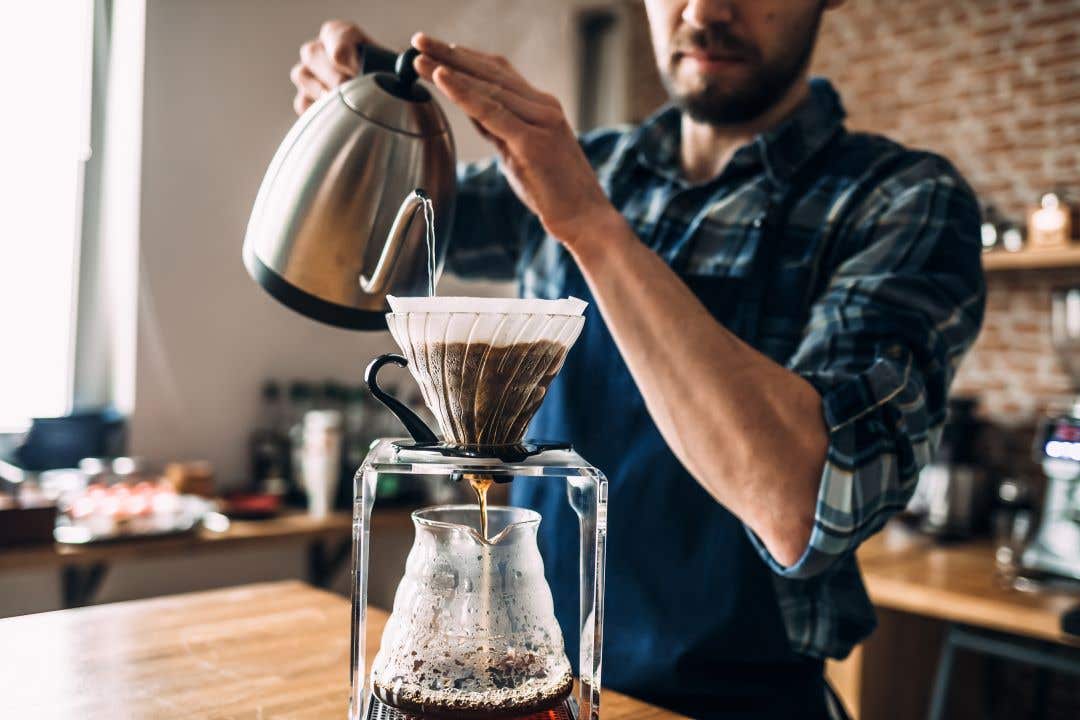Physics can help you brew better coffee with fewer beans
Your morning coffee faces a growing threat. Climate change is impacting coffee crops globally, especially Arabica beans, known for their delicate taste and sensitivity to temperature changes. These challenges have…

Physicists reveal a new brewing method using controlled pours and fluid dynamics to extract more coffee flavor from fewer beans. (CREDIT: CC BY-SA 4.0)
Your morning coffee faces a growing threat. Climate change is impacting coffee crops globally, especially Arabica beans, known for their delicate taste and sensitivity to temperature changes. These challenges have caused Arabica bean prices to rise sharply, driven by four consecutive years of poor weather. Researchers at the University of Pennsylvania are now looking at an unusual solution: better brewing through physics.
Their study, published in the journal Physics of Fluids, reveals that altering how water meets coffee grounds can make your coffee richer while using fewer beans. This breakthrough may help ease global demand pressures on coffee production.
Understanding the Avalanche Effect
When you prepare coffee, hot water meets coffee grounds, extracting flavors into your cup. This simple action involves complex physics. Arnold Mathijssen, assistant professor of physics at the University of Pennsylvania, explains, “There’s a lot of research on fluid mechanics, and there’s a lot of research on particles separately. Maybe this is one of the first studies where we start bringing these things together.”
To reveal how brewing works beneath the surface, the team replaced coffee grounds with clear silica gel particles. Using a glass cone, laser sheet, and high-speed camera, they observed how water interacts with particles during a pour-over brew.
They noticed something remarkable: as water flows into the coffee bed, it triggers a miniature avalanche, mixing particles vigorously. This movement significantly boosts how flavors are extracted. Even gentle pours created this avalanche effect, enhancing coffee extraction.
Getting More Coffee from Fewer Beans
The avalanche discovery suggested a powerful brewing strategy. Graduate researcher Ernest Park says, “We tried finding ways where we could use as little coffee as possible and just take advantage of the fluid dynamics of the pour.”
Related Stories
Testing various pour heights and water speeds provided valuable insights. Pouring water from a higher position strengthened mixing, improving extraction. However, if poured from too high, water droplets broke apart mid-air, reducing extraction efficiency by adding unwanted air bubbles.
Next, the researchers switched back to actual coffee grounds. Measuring dissolved coffee solids confirmed their findings. They discovered that a slower, more controlled pour increased extraction rates significantly. This careful method means you could use fewer beans without compromising flavor.
Park emphasizes the importance of using the right equipment. “If you were just to use a regular water kettle, it’s a little bit hard to control where the flow goes,” he notes. A special gooseneck kettle produces smooth, controlled water flow, essential for effective brewing. This type of flow is called laminar, meaning smooth, uninterrupted water streams that maximize contact with coffee grounds.
Graduate researcher Margot Young explains further, “When you’re brewing a cup, what gets all of that coffee taste and all of the good stuff from the grounds is contact between the grounds and the water.” Better contact through controlled pouring means a richer, tastier cup with fewer beans.
Beyond the Coffee Cup: Bigger Implications
Although inspired by daily coffee brewing, these results could affect far more than your morning beverage. Mathijssen highlights this point clearly: “We weren’t just doing this for fun. We had the tools from other projects and realized coffee could be a neat model system to explore deeper physical principles.”
Their work with coffee revealed fundamental processes common in nature and industry. Young points out, “This kind of fluid behavior helps us understand how water erodes rock under waterfalls or behind dams.” Similar particle-fluid interactions happen during wastewater treatment and filtration.
Park applies these fluid dynamics principles to medical technology, working on microscopic surfaces that use magnetic fields to clean medical devices. Meanwhile, Young explores fluid movement in biology. She uses the same high-speed imaging technique to study how tiny hair-like structures in lungs help clear infections.
“You can start small, like with coffee,” Mathijssen says. “And end up uncovering mechanisms that matter at environmental or industrial scales.”
Practical Brewing Advice
To use these findings at home, adjust how you pour water onto your coffee. Choose a gooseneck kettle, allowing smoother, steady flow. Begin pouring from a moderate height to create gentle avalanches, effectively mixing grounds without introducing air bubbles. Avoid overly rapid pouring to keep extraction rates consistently high, and experiment with pour heights and flow speeds to find your ideal flavor balance.
Doing this can drastically cut how many beans you use each morning without sacrificing your coffee's taste or strength. Given rising coffee prices and environmental pressures, this strategy might help save money while reducing global coffee demand.
Young emphasizes that these methods improve sustainability. By making each bean count, the coffee industry could better manage limited resources, especially amid growing climate challenges.
A Fresh Perspective on a Familiar Routine
Though coffee drinking is an ancient practice, fresh perspectives on how we brew can reveal new efficiencies. Science provides ways to enhance everyday habits, like coffee making, benefiting both our environment and daily life quality.
Mathijssen sums up the broader importance of their research clearly, “We had the tools from other projects and realized coffee could be a neat model system.” The simplicity of coffee brewing opens doors to understanding many complex natural processes. It also highlights how small changes in daily routines can have substantial benefits.
For coffee drinkers worldwide, this means every cup brewed thoughtfully not only tastes better but contributes positively to sustainability goals. The next time coffee fills your cup, consider the physics behind it—a small act of brewing can support a much larger cause.
Note: The article above provided above by The Brighter Side of News.
Like these kind of feel good stories? Get The Brighter Side of News' newsletter.
Rebecca Shavit
Science & Technology Journalist | Innovation Storyteller
Based in Los Angeles, Rebecca Shavit is a dedicated science and technology journalist who writes for The Brighter Side of News, an online publication committed to highlighting positive and transformative stories from around the world. With a passion for uncovering groundbreaking discoveries and innovations, she brings to light the scientific advancements shaping a better future. Her reporting spans a wide range of topics, from cutting-edge medical breakthroughs and artificial intelligence to green technology and space exploration. With a keen ability to translate complex concepts into engaging and accessible stories, she makes science and innovation relatable to a broad audience.



